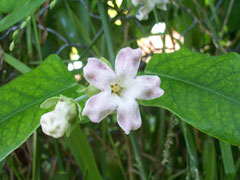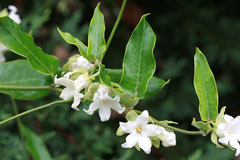 |
|
http://commons.wikimedia.org/wiki/File:Araujia_sericifera_flower.JPG |
 |
| http://flickr.com/photos/arthur_chapman/3255884277 |
Translate this page:
Summary
Araujia sericifera or white bladderflower is a perennial climbing ornamental plant often found on sandy sea shores. It has minor edible uses and has been used a a fibre for making textiles. Common names include: Moth Plant, White Bladderflower, Common Moth Vine, Cruel Vine and False Choko.
Physical Characteristics

 Araujia sericifera is an evergreen Climber growing to 10 m (32ft 10in) at a fast rate.
Araujia sericifera is an evergreen Climber growing to 10 m (32ft 10in) at a fast rate.
See above for USDA hardiness. It is hardy to UK zone 9 and is frost tender. It is in leaf all year, in flower in September. The species is hermaphrodite (has both male and female organs) and is pollinated by Lepidoptera (Moths & Butterflies).
Suitable for: light (sandy) and medium (loamy) soils. Suitable pH: mildly acid, neutral and basic (mildly alkaline) soils. It can grow in semi-shade (light woodland) or no shade. It prefers moist soil.
UK Hardiness Map
US Hardiness Map
Synonyms
Plant Habitats
Cultivated Beds; South Wall. By. West Wall. By.
Edible Uses
Edible Parts: Fruit
Edible Uses:
Fruit - after preparation[177]. No further details are given but the fruit is a long grooved pod 12.5 x 7.5cm, tapering to a fascicle of hairs 2.5cm long[200].
References More on Edible Uses
Medicinal Uses
Plants For A Future can not take any responsibility for any adverse effects from the use of plants. Always seek advice from a professional before using a plant medicinally.
None known
References More on Medicinal Uses
The Bookshop: Edible Plant Books
Our Latest books on Perennial Plants For Food Forests and Permaculture Gardens in paperback or digital formats.

Edible Tropical Plants
Food Forest Plants for Hotter Conditions: 250+ Plants For Tropical Food Forests & Permaculture Gardens.
More

Edible Temperate Plants
Plants for Your Food Forest: 500 Plants for Temperate Food Forests & Permaculture Gardens.
More

More Books
PFAF have eight books available in paperback and digital formats. Browse the shop for more information.
Shop Now
Other Uses
Fibre
A strong fibre obtained from stems is used in making textiles[46, 61]. As an ornamental. The plant can be used as an alternative food source for caterpillars of the Monarch butterfly.
Special Uses
Scented Plants
References More on Other Uses
Cultivation details
Prefers a good loamy soil but succeeds in any fertile soil[11, 182]. Requires a sunny position[182]. Plants are not very hardy outdoors in Britain, they succeed outdoors only in the mildest areas of the country[1, 11]. The young growth in spring, even on mature plants, is frost-tender and so it is best to grow the plants in a position sheltered from the early morning sun[K]. Plants produce fruit when growing on a wall at Glendurgan gardens in Cornwall[59]. A very vigorous twining plant when growing in a suitable position[182, 219]. The flowers have a very strong scent that can be offensive if approached too closely[219]. This scent attracts night-flying moths who are seeking nectar, but the flowers are designed in such a way as to trap the moths by their tongues until morning when those who have survived the ordeal can escape[200, 219].
References Carbon Farming Information and Carbon Sequestration Information
Temperature Converter
Type a value in the Celsius field to convert the value to Fahrenheit:
Fahrenheit:
The PFAF Bookshop
Plants For A Future have a number of books available in paperback and digital form. Book titles include Edible Plants, Edible Perennials, Edible Trees,Edible Shrubs, Woodland Gardening, and Temperate Food Forest Plants. Our new book is Food Forest Plants For Hotter Conditions (Tropical and Sub-Tropical).
Shop Now
Plant Propagation
Seed - sow spring in a greenhouse. The seed can be sown at any time of the year if the greenhouse is heated[134]. Germinates in 3 - 6 weeks at 20°c according to one report whilst another says that it takes 1 - 6 months at 25°c[134]. When large enough to handle, prick the seedlings out into individual pots and grow them on in the greenhouse for their first winter. Plant them out in late spring or early summer, after the last expected frosts. Cuttings of mature wood of the current seasons growth, late autumn in a frame[1].
Other Names
If available other names are mentioned here
Moth Plant, White Bladderflower, Common Moth Vine, Cruel Vine and False Choko.
Native Range
SOUTHERN AMERICA: Brazil (Minas Gerais, Paraná, Rio de Janeiro, Rio Grande do Sul, Santa Catarina, São Paulo), Argentina (Buenos Aires, Corrientes, Entre Ríos, Misiones, Santa Fe), Paraguay (Alto Paraná, Guairá, Itapúa), Uruguay
Weed Potential
Right plant wrong place. We are currently updating this section.
Please note that a plant may be invasive in one area but may not in your area so it's worth checking.
This plant can be weedy or invasive. Noted as a noxious weed in California (bladderflower) B list (noxious weeds). Listed in the National Pest Plant Accord in New Zealand to prevent the sale, distribution, or propagation, within New Zealand, of specified pest plants.
Conservation Status
IUCN Red List of Threatened Plants Status : This taxon has not yet been assessed.

Growth: S = slow M = medium F = fast. Soil: L = light (sandy) M = medium H = heavy (clay). pH: A = acid N = neutral B = basic (alkaline). Shade: F = full shade S = semi-shade N = no shade. Moisture: D = dry M = Moist We = wet Wa = water.
Now available:
Food Forest Plants for Mediterranean Conditions
350+ Perennial Plants For Mediterranean and Drier Food Forests and Permaculture Gardens.
[Paperback and eBook]
This is the third in Plants For A Future's series of plant guides for food forests tailored to
specific climate zones. Following volumes on temperate and tropical ecosystems, this book focuses
on species suited to Mediterranean conditions—regions with hot, dry summers and cool, wet winters,
often facing the added challenge of climate change.
Read More
Expert comment
Author
Brot.
Botanical References
1174200
Links / References
For a list of references used on this page please go here
Readers comment